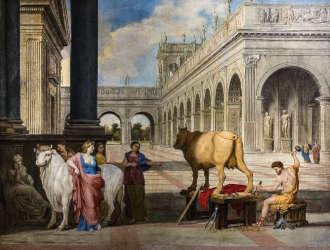Minotaur, half-bull and half-human monster in the labyrinth
The creature by the name of Asterius was a consequence of the unnatural and bizzare union of Pasiphae, queen of Crete and wife of Minos, and the bull sent by Poseidon. It is said that it had a face of a bull and body of a human or, alternatively, upper body of a bull and lower body of a human. Authors seem to agree that it was a hybrid of monstrous shape that was called the Minotaur. Its fate was tied to the labyrinth to prey upon men and women who would lose their way in this endless maze.
The birth of the Minotaur
It all began when a bull of extraordinary beauty has emerged in one of the flocks of king Minos in Crete. According to Apollodorus' Library, it was Poseidon himself who gifted this bull to Minos for past devotion.  It was a custom for Minos to sacrifice the finest bull annualy to the god of the sea but Minos instead chose to sacrifice another in the herd. This angered Poseidon who made the bull savage and enchanted Pasiphae to have a passion for it. Alternatively, according to Hyginus, Pasiphae failed to honor Aphrodite with offerings for several years, which angered the goddess and made her cast a spell on the queen to fall in love with the bull. Pasiphae then asked Daedalus, a famous inventor who was living as a refugee in Crete at the time, to help her facilitate this unnatural passion. The hero complied by building a wooden cow for her to hide inside and mate with the bull. The result of this "crafty mating", as Virgil called it, was the Minotaur.
It was a custom for Minos to sacrifice the finest bull annualy to the god of the sea but Minos instead chose to sacrifice another in the herd. This angered Poseidon who made the bull savage and enchanted Pasiphae to have a passion for it. Alternatively, according to Hyginus, Pasiphae failed to honor Aphrodite with offerings for several years, which angered the goddess and made her cast a spell on the queen to fall in love with the bull. Pasiphae then asked Daedalus, a famous inventor who was living as a refugee in Crete at the time, to help her facilitate this unnatural passion. The hero complied by building a wooden cow for her to hide inside and mate with the bull. The result of this "crafty mating", as Virgil called it, was the Minotaur.
Imprisoned in the labyrinth
As a consequence of this affair and the abomination that was brought to life, Minos imprisoned Daedalus and, after consulting with the oracles, instructed him to construct a maze with an undiscoverable exit in which the Minotaur was confined and hidden from the world. It was called the labyrinth or, according to different authors, a chamber or a passage-way with tangled windings that prevented anyone unfamilliar from finding way out. Virgil called it "a maze inextricable" meaning it was impossible to escape from. According to Pausanias, the location of the labyrinth was in the Knossos region which was the capital of Crete and the Minoan civilization.
Human sacrifices to the Minotaur
It is said that after the Minoans had won over Athenians, king Minos decreed that every year they had to send seven youths and seven maidens to be sacrificed to the Minotaur in the labyrinth. Alternatively, according to Plutarch, it was every nine years that was agreed upon to appease the king. Either way, in each of these offerings, the victims were destroyed by the Minotaur in the Labyrinth, or else wandered about at their own will and, being unable to find an exit, perished there. This monstrosity has finally ended when Theseus came to Crete as a part of the offerings. The hero was welcomed by Ariadne, a daughter of Minos, who, being very attracted to his handsome appearance, later helped him by revealing the way out of labyrinth. It is said that Theseus considered this victory the most noteworthy of his achievements, not so much because the Minotaur was the toughest opponent, but because his success in unravelling the difficult Maze and in escaping unnoticed along with Ariadne.